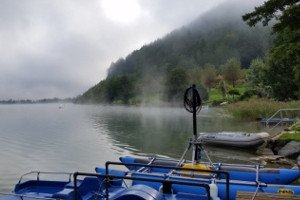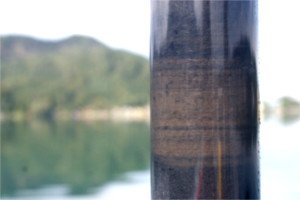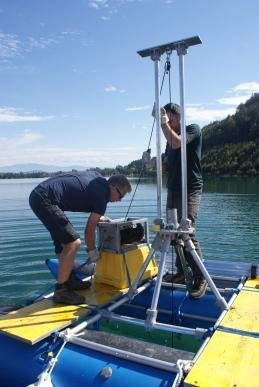Quantitative lacustrine paleoseismology in Carinthia, Austria: improving the Environmental Seismic Intensity Scale and assessing strong earthquake recurrence in formerly-glaciated intraplate settings (Quake-Lake Carinthia)
Funded by the Austrian Science Fund (FWF) (09.2017-08.2022)
PI: Jasper Moernaut
Co-PI: Michael Strasser
Project Members: Christoph Daxer, Ariana Molenaar

Despite being considered a country of moderate seismicity, several historical earthquakes in Austria caused massive impact on infrastructures and landscape. Seismological data and historical records generally do not extend far enough back in time to make correct estimates of where and how often such catastrophic events could take place. It is possible that very strong earthquakes took place in prehistorical times and are thus overlooked in the present estimates of seismic hazard. As a consequence, future events may come with an “unexpected” large impact to (critical) infrastructure and excessive economic and human losses.
We overcome this knowledge barrier by using lake sediments as natural seismometers. Strong earthquakes can deform lacustrine sediments and produce underwater landslides.

Due to the continuous accumulation of mud on the lake bottom, such evidence of past earthquakes gets preserved and can get retrieved by geophysical techniques and sampled by sediment cores. The Quake-Lake Carinthia project applies this paleoseismic research strategy on the large lakes in Carinthia, one of Austrias most seismic areas. Due to its unique setting −where many lakes have been impacted by several well-documented historical earthquakes− we determine relationships between the strength of shaking and the characteristics of the sedimentary features. In this way, our records do not only show when strong earthquakes took place in the last 14.000 yrs, but also show how strong they were and in which area their epicenter was located. These long earthquake archives will also generate new insights about how earthquake activity changed over time as a consequence of the melting of the alpine icecap since the last Ice Age.

Paleoseismological research is relatively new in Austria, and lake sediments as a natural earthquake archive have not been studied there. We implement and improve the newest methods in lacustrine paleoseismology: i) in-situ geotechnical tests to calculate how strong shaking needs to be to destabilize underwater slopes, ii) different geochemical and physical proxies to better understand the nature of the earthquake impact on lake sediments and surrounding landscapes.
The detailed work on the Carinthian lakes forms the fundaments of a worldwide comparison of lake paleoseismology, where we evaluate how different sedimentary features in different lake systems can be used to reveal the shaking strength of past earthquakes. We combine present and new knowledge to construct a generic methodology which can be applied to improve seismic hazard assessments in many places worldwide.
Publications (peer-reviewed):
Overview
Moernaut, J., 2020. Time-dependent recurrence of strong earthquake shaking near plate boundaries: a lake sediment perspective. Earth Science Reviews 210, 103344. doi: 10.1016/j.earscirev.2020.103344
Carinthia and Tyrol:
Daxer, C., Huang, J.-J., Weginger, S., Hilbe, M., Strasser, M., Moernaut, J., 2022. Validation of seismic hazard curves using a calibrated 14 ka lacustrine record in the Eastern Alps, Austria. Scientific reports 12, 19943. https://doi.org/10.1038/s41598-022-24487-w
Daxer, C., Ortler, M., Fabbri, S.C., Hilbe, M., Hajdas, I., Dubois, N., Piechl, T., Hammerl, C., Strasser, M., Moernaut, J., 2022. High-resolution calibration of seismically induced lacustrine deposits with historical earthquake data in the Eastern Alps (Carinthia, Austria). Quaternary Science Reviews 284, 107497. doi:10.1016/j.quascirev.2022.107497
Oswald, P. Strasser, M., Skapski, J., Moernaut, J., 2022. Magnitude and source area estimations of severe prehistoric earthquakes in the western Eastern Alps. Natural Hazards and Earth System Sciences 22, 2057-2079. doi:10.5194/nhess-22-2057-2022
Kiefer, C., Oswald, P., Moernaut, J., Fabbri, S.C., Mayr, C., Strasser, M., Krautblatter, M., 2021. A 4,000 year debris-flow record based on amphibious investigations of fan delta activity in Plansee (Austria, Eastern Alps). Earth Surface Dynamics. doi:10.5194/esurf-9-1481-2021
Oswald, P., Moernaut, J., Fabbri, S.C., De Batist, M., Hajdas, I., Ortner, H., Titzler, S., Strasser, M., 2021. Combined on-fault and off-fault paleoseismic evidence in the postglacial infill of the inner-alpine lake Achensee (Austria, Eastern Alps). Frontiers in Earth Science. Doi:10.3389/feart.2021.670952
Oswald, P., Strasser, M., Hammerl, C., Moernaut, J., 2021. Seismic control of large prehistoric rockslides in the Eastern Alps. Nature Communications. doi: 10.1038/s41467-021-21327-9
Daxer, C., Sammartini, M., Molenaar, A., Pichl, T., Strasser, M., Moernaut, J.,2020. Morphology and spatio-temporal distribution of lacustrine landslides in Wörthersee, Eastern Alps, Austria. Geological Society of London, Special Publications 500. doi:10.1144/SP500-2019-179
Process-oriented studies in Chile and Alaska
Molenaar, A., Van Daele, M., Huang, J.-J., Strasser, M., De Batist, M., Pino, M., Urrutia, R., Moernaut, J., 2022. Disentangling factors controlling earthquake-triggered soft-sediment deformation in lakes. Sedimentary Geology. doi:10.1016/j.sedgeo.2022.106200.
Praet, N., Van Daele, M., Moernaut, J., Mestdagh, T., Vandorpe, T., Jensen, B., Witter, R.C., Haeussler, P.J., De Batist, M., 2022. Unravelling a 2300 year long sedimentary record of megathrust and intraslab earthquakes in proglacial Skilak Lake, south-central Alaska. Sedimentology. doi.org/10.1111/sed.12986
Molenaar, A., Van Daele, M., Vandorpe, T., Degenhart, G., De Batist, M., Urrutia, R., Pino, M., Strasser, M., Moernaut, J., 2021. What controls the remobilization and deformation of surficial sediment by seismic shaking? Linking lacustrine slope stratigraphy to great earthquakes in South-Central Chile. Sedimentology. doi.org/10.1111/sed.12856
Praet, N., Van Daele, M., Collart, T., Moernaut, J., Vandekerkhove, E., Kempf, P., Haeussler, P.J., De Batist, M., 2020. Turbidite stratigraphy in proglacial lakes – deciphering turbidite trigger mechanisms using a statistical approach. Sedimentology. doi:10.1111/sed.12703
Moernaut, J., Van Daele, M., Heirman, K., Wiemer, G., Molenaar, A., Vandorpe, T., Melnick, D., Hajdas, I., Pino, M., Urrutia, R., De Batist, M., 2019. The subaqueous landslide cycle in south-central Chilean lakes: the role of tephra, slope gradient and repeated seismic shaking. Sedimentary Geology 381, 84-105.
doi: 10.1016/j.sedgeo.2019.01.002
Van Daele, M., Araya-Cornejo, C., Pille, T., Vanneste, K., Moernaut, J., Schmidt, S., Kempf, P., Meyer, I., Cisternas, M., 2019. Distinguishing intraplate from megathrust earthquakes using lacustrine turbidites. Geology 47(2), 127-130. doi: 10.1130/G45662.1
Main Project Collaborators:
Christa Hammerl / Stefan Weginger (ZAMG - Central Institute for Meteorology and Geodynamics, Vienna)
Wolfgang Recheis / Gerald Degenhart / Markus Erhardt (Innsbruck Medical University)
Stefano Fabbri (University of Bern)
Marc De Batist / Maarten Van Daele / Nore Praet (Ghent University)
Patrick Oswald (University of Innsbruck)
